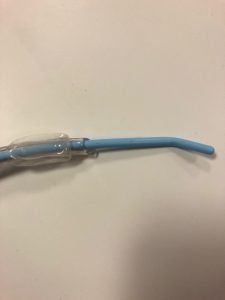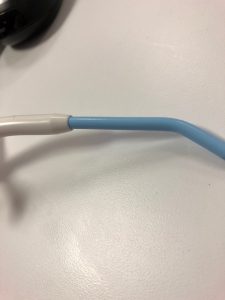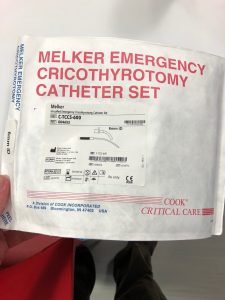As the title implies, this is a strange pearl. Imagine the following:
You are in a can’t intubate/can’t ventilate scenario. The patient’s neck is large, and the landmarks are poor. You cut through a depth of redundant tissue to get to the cricothyroid membrane, make your incision, insert your finger, and place a bougie. The bougie is in place, but the 6.5 mm endotracheal tube is getting caught on the redundant tissue and will not pass.
This is an unlikely scenario, indeed. With that said, there is a small gap between the bougie and a 6.5 endotracheal tube.
Enter the Melker catheter: the catheter contained in the percutaneous cricothyrotomy kits stocked by many departments. Cook® sells kits with both cuffed and uncuffed Melker catheters. The inner diameter of the Melker catheter is almost exactly the outer diameter of the bougie; there is no gap.
The Melker catheter offers a two distinct disadvantages over a tracheostomy catheter or a standard 6.5 endotracheal tube:
(1) The uncuffed Melker catheter (stocked at Mount Sinai) is an uncuffed airway. You can put a patient with an uncuffed airway on a vent, but it won’t work very well. With that said, unless the patient requires PEEP to oxygenate, you should be able to oxygenate fine.
(2) The Melker catheter is a very small airway, and managing a ventilated patient with a small airway presents challenges. Laminar flow is tough to come by in a small tube. The smaller the tube, the lower the flow rate at which laminar flow becomes turbulent. Turbulent flow increases the work of breathing for the patient, and can increase air trapping.
The more proximate risk to the patient in the emergency department with a small airway is the catheter becoming plugged. Small airways get plugged with secretions and obstruct easily. Moreover, suctioning and pulmonary toilet is challenging/impossible in small airways.
References:
Parameswaran, A., L. Beckmann, and P. Nadarajah. “An adjunct to the scalpel-bougie cricothyroidotomy.”
Farrow, S., C. Farrow, and N. Soni. “Size matters: choosing the right tracheal tube.” Anaesthesia 67.8 (2012): 815-819.



